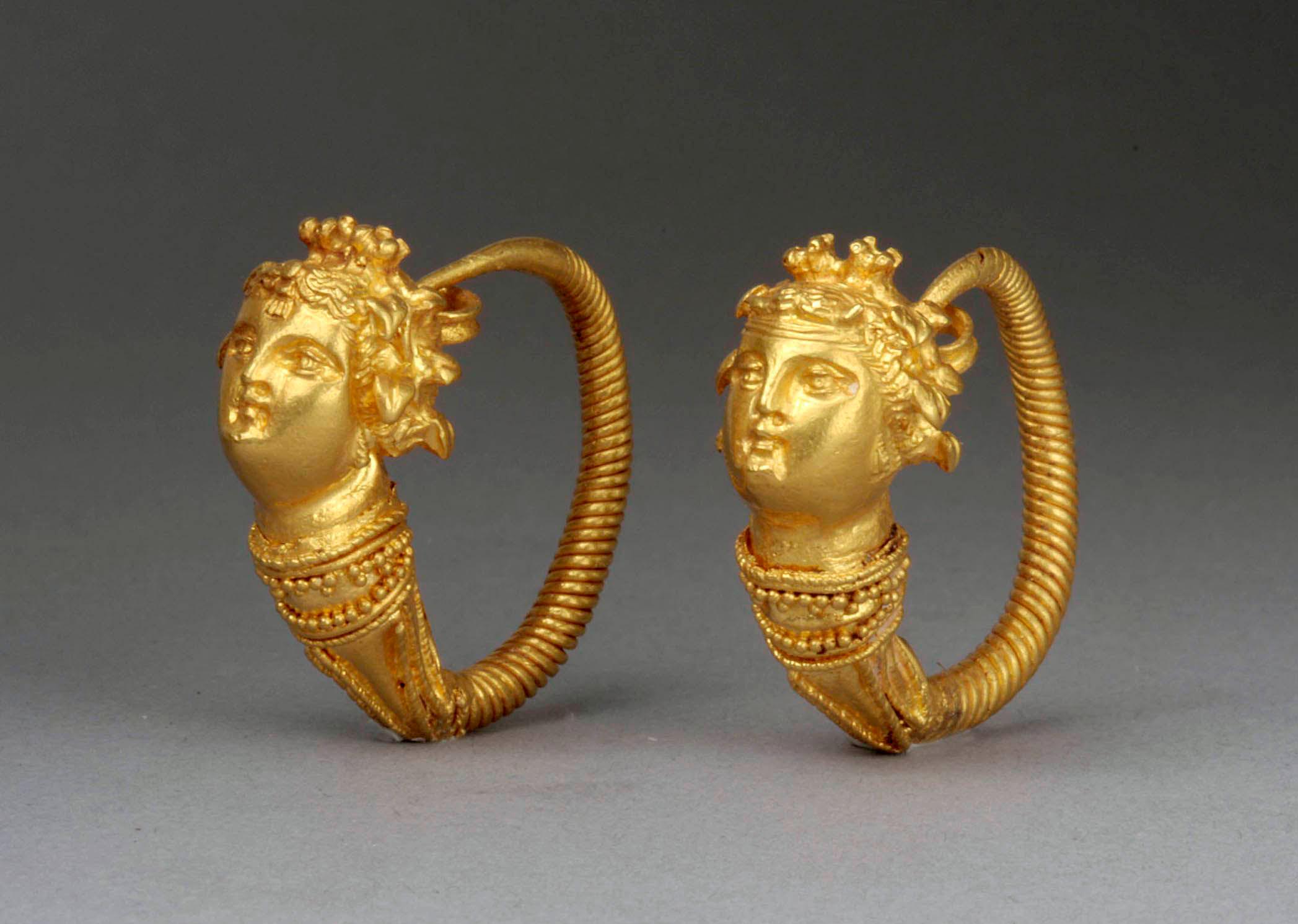
Earring with head of Dionysos
Date: 2nd-1st century B.C.E.
Dimensions:
L. 1 1/16 in. (2.6 cm) - Dealer Dimensions
Medium: Gold; repoussé, filigree, granulation
Place of Origin: Hellenistic
Classification: Jewelry
Credit Line: Purchased with funds from the Libbey Endowment, Gift of Edward Drummond Libbey, by exchange
Object number: 2008.165A
Label Text:The Hellenistic world had a craving for gold jewelry and the elite commissioned vast amounts of it for personal adornment, temple offerings, and funerary gifts. Craftsmen perfected the art by using various techniques such as repousse (molded from the back), filigree (twisted threads of precious metal), and granulation (“grains” or small balls of gold attached to a surface).
The two hollow heads were shaped in the same die mold. A ribbon across his forehead differentiates the god Dionysos from his bride Ariadne.
The two hollow heads were shaped in the same die mold. A ribbon across his forehead differentiates the god Dionysos from his bride Ariadne.
DescriptionEach earring depicts a head, one of Dionysus, one of Ariadne. Each head fits into a collar which terminates in a twisted wire spiral. The spiral then forms a loop that hooks into a ring soldered onto the back of the head.
Heads hammered from sheet gold in a circular die with at least two sections (seam visible across top of head from ear to ear). Details of fillet/forehead pendant, hair, eyes, nostrils, and mouths added by chasing and punching.
The hoop of the earring is made from three flat gold strips twisted together, the ends hammered together and tapered to a point for insertion through the back of the earlobe, with hook and loop fastening.
Head and hoop were joined by a conical collar of sheet gold tongues decorated with beaded wire filigree, attached both mechanically and with solder, with additional wire "necklaces" to strengthen t he join.
The Greek goldsmith made these exquisite miniature sculptures by raising hollow heads from sheet gold hammered over a matrix, or matrices, that included the topknot, curls of hair, and ivy leaf diadem. The heads were then differentiated into Dionysos and Ariadne by adding different attributes, including the taenia (fillet) across the forehead of Dionysos and the forehead jewel of Ariadne.
In spite of the small scale, the heads are exquisitely detailed, including elaborated curled and upswept hair and ivy wreaths.
Hellenistic jewelry frequently incorporated Dionysiac imagery, and earrings with maenad heads were particularly favored in the area of Syria. This type of earring was fashionable from the late fourth century B.C.E. until at least the first century C.E. Examples have been found in Italy, Greece, Cyprus, and around the Black Sea and Aegean Sea.
Heads hammered from sheet gold in a circular die with at least two sections (seam visible across top of head from ear to ear). Details of fillet/forehead pendant, hair, eyes, nostrils, and mouths added by chasing and punching.
The hoop of the earring is made from three flat gold strips twisted together, the ends hammered together and tapered to a point for insertion through the back of the earlobe, with hook and loop fastening.
Head and hoop were joined by a conical collar of sheet gold tongues decorated with beaded wire filigree, attached both mechanically and with solder, with additional wire "necklaces" to strengthen t he join.
The Greek goldsmith made these exquisite miniature sculptures by raising hollow heads from sheet gold hammered over a matrix, or matrices, that included the topknot, curls of hair, and ivy leaf diadem. The heads were then differentiated into Dionysos and Ariadne by adding different attributes, including the taenia (fillet) across the forehead of Dionysos and the forehead jewel of Ariadne.
In spite of the small scale, the heads are exquisitely detailed, including elaborated curled and upswept hair and ivy wreaths.
Hellenistic jewelry frequently incorporated Dionysiac imagery, and earrings with maenad heads were particularly favored in the area of Syria. This type of earring was fashionable from the late fourth century B.C.E. until at least the first century C.E. Examples have been found in Italy, Greece, Cyprus, and around the Black Sea and Aegean Sea.
On view
In Collection(s)

